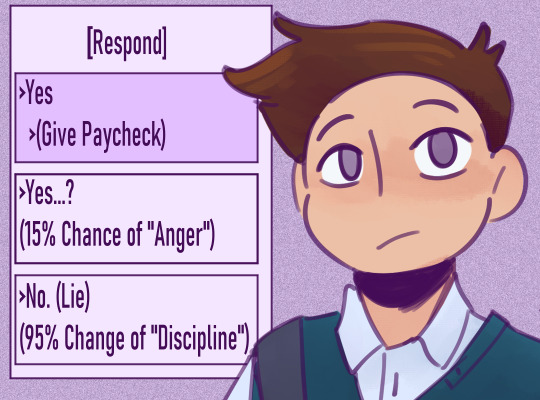#because i like the idea of mixing the two genres of fantasy pinocchio-like creature with sci-fi machinery
Explore tagged Tumblr posts
Note
So, a changeling is sort of like a p-zombie?
(For the unaware, “p-zombie” stands for “philosophical zombie”. It’s a thought experiment in philosophy that describes a being that’s outwardly identical to a human, but does not have a consciousness; that is, a p-zombie does not think whatsoever, although it looks like it thinks to an outsider observer. There’s a whole wikipedia article on it that explains the concept better than I can!)



They don't exactly think, as in "I dont want this" "I like that". But, Changelings do have a form of "Consciousness". It's just that their consciousness is more like a series of commands or tasks than actual formulated thoughts.
Timmy's Changeling has a very advanced "consciousness". It can predict future actions and reroute its tasks to pick only the best options for its situation.
We fill their heads with static to ensure that the Changeling does not form thoughts about anything. Thoughts leads to opinions, and opinions leads to incorrect actions. A proper Changeling should have more static in their mind than a TV screen on a defunct channel!
Bitties Series: [Start] > [Previous] > [Next]
#fairly oddparents#fop#fop a new wish#fop timmy turner#fop timmy#timmy turner#chimmy changa#asks#itty bitties fop au#changelings are like. a mix between puppetry and pre-programmed coding#because i like the idea of mixing the two genres of fantasy pinocchio-like creature with sci-fi machinery#(<- watched the pinocchio 3000 movie as a kid and it changed my brain chemistry)#the bigger and louder the static the less theyre capable of creating thoughts!!!!#man its a good thing we can increase the amount of static a changeling has. good thing static is all powerful and can never ever be ignored#hahahahahhahahaha#fun fact the simplier the changeling the less static it needs#hazel's changeling doesnt even have a set of commands#it like. it doesnt even have a consciousness. nothing but pure vibes and movement. and space.#'but cubs! chimmy has likes and dislikes! doesnt that count as thoughts??' i hear you ask#and the answer to that is.#hrm. it shouldnt be doing that.
453 notes
·
View notes
Text
I love Gaslight fantasy
I love Gaslight fantasy. Gaslight fantasy is also known as Gaslamp fantasy. And before I go any further, no I am not “Confusing” the terms. Gaslighting as a term comes from a 1940s film called “Gaslight” where a man tricks a woman into doubting her perceptions of reality. The concept of “gaslighting” as a verb to mean this didn’t exist until that film. The title of the film was named for the object, “gaslights” which were common in the late nineteenth and early twentieth century.
This has nothing to do with “gaslighting.” I should not have had to explain this but... Tumblr...
There is a new genre of fantasy / Gothic horror fiction called Gaslight fantasy. This genre can be compared to High Fantasy, Gothic Horror, and Steampunk in many aspects and yet it is wholly it’s own entity.
Gaslight Fantasy is a genre where a fantasy world resembles our world’s Victorian era but the supernatural such as monsters and magick are known to be real. It bears a lot of elements of Gothic Horror and many examples of Gaslight Fantasy also fit the genre of Gothic Horror but unlike the term “Gothic Fantasy” which feels like an attempt to circumvent acknowledging that Gothic Horror is a form of Horror, Gaslight Fantasy can exist in tandem with Gothic Horror as descriptors for the same property. As a result it is a new sub-genre I welcome as opposed to “Gothic Fantasy” which feels like a term invented by those embarrassed of liking horror.
Example: Barnes and Noble slapping “Gothic Fantasy” across the cover of their leather bound versions of The Works of Edgar Allan Poe, and H. P. Lovecraft, as well as Dracula, and Frankenstein. Those are all Gothic Horror and the use of “Gothic Fantasy” feels like a term for those ashamed of the horror aspect or don’t realize horror can be more than just gore and jump scares.
Further note: Frankenstein is often considered the first science fiction novel but Victor found the secret of life while reading the works of Agrippa and Paracelsus, a self-proclaimed alchemist and sorcerer. Also Victor was studying metaphysics, not biology. The Frankenstein monster is often considered (in fantasy-loving circles) to be a “Flesh golem with a soul.” Psuedo-intellectualists seem to chafe at the idea that Frankenstein is a horror story and prefer to call it science fiction because there is still this incorrect ant antiquated notion that horror is low brow and cannot contain romanticism or emotional, spiritual, and moral explorations.
Even The Shape of Water, which can easily be mistaken as a remake of Creature from the Black Lagoon and Revenge of The Creature (But with a happy ending for The Creature) is often called “Supernatural romance” instead of Horror even though there are scary moments, atmosphere, violence, death, supernatural elements, and other things usually associated with the horror genre.
The same thing happened with Silence of the Lambs, which was branded “Thriller” when it got its Oscar nomination. It seems the Oscar nomination might be why The Shape of Water isn’t classified as horror either.
Director Guillermo del Toro (though a clear lover of Gothic Horror) seems reluctant to classify his own films as Gothic Horror even though Crimson Peak is clearly paying homage to Mario Bava’s Black Sabbath and Hammer Horror films.
It’s the cultural resentment of Gothic Horror that makes me dislike the term “Gothic Fantasy” but I am willing to embrace the new idea of Gaslight Fantasy that can exist within Gothic Horror or side by side with it, in the same story.
Though it’s still a relatively new genre I do love the refreshingly new concept of Gaslight Fantasy as a reimagined Victorian era that isn’t just full of zeppelins, steam engines and gears (like the typical superficial Steampunk tropes) but also supernatural creatures and or magick being common place. Not to mention so many fantasy stories are set in a pseudo-Middle ages Europe-esque land like in Game of Thrones and The Witcher, that it’s clever and different that the fantasy world doesn’t look like the late dark ages but instead the late nineteenth century, just to give it a different aesthetic and atmosphere while retaining a sense of wonder and historical nostalgia, though blatantly and deliberately inaccurate.

Examples of Gaslight Fantasy include: Amazon Prime’s Carnival Row - Set in a nineteenth century style city where humans, faeries, werewolves, Franeknstein-style monsters, trolls, fauns, and centaurs co-exist. This is probably the first true, mainstream, gaslight fantasy and the best example of the genre. It deals with Jack the Ripper style murders in a slum inhabited by magical creatures. It’s a lot like Penny Dreadful but Penny Dreadful pretends to be set in our world where most people do not know the supernatural exists whereas Carnival Row is not quite our world and people know about most of the supernatural creatures who reside there.
Dolls of New Albion - Dolls of New Albion is described as a steampunk musical, is set in a world where human souls can be summoned from Elysium (Greek Heaven) and inserted into semi-mechanical dolls. The fact that the afterlife is treated as a common knowledge fact in a world that just resembles ours in the Victorian era, and human souls can be inserted into doll-like bodies indicates to me that this actually drifts into Gaslight fantasy.
The movie Van Helsing- Though this film is what I would call Goth Action (Gothic Horror merged with action) the film Van Helsing is very much what I would consider Gaslight fantasy. Set in what looks like our world’s Victorian era and even using real-world place names there are distinct differences, such as The Vatican behaving as a secret monster hunting organization instead of just the Capital of the Catholic Church. Similar can be said about the setting of Castlevania that is distinctly another world even though it resembles ours and has our European place names though that one is set in the fifteenth century.
Howl’s moving Castle - Though bearing Steampunk elements, the common knowledge of magick, in a setting that is not quite our world, and reminiscent of the Victorian era of our world, or even the Edwardian era, makes Howl’s Moving Castle very much a Gaslight fantasy.
League of Extraordinary Gentlemen - Though easily considered Steampunk or Gothic Horror, League of Extraordinary Gentlemen bears some fantasy elements mixed with the horror and the resemblance to our world is dubious at best.
Stardust - The film and novel by Neil Gaiman deal with a wall that separates the human world from the realm of Faerie and a young man’s journey where he meets a fallen star in humanoid form, and his own long lost mother. In this world the barrier between the human world and the realm of magick is a known and tangible fact.
Discworld - The Discworld books by Terry Pratchett are set in a fantasy world known as.. the Disworld, supported by four elephants riding on the back of a giant turtle, the Discworld pays homage to and parodies fantasy tropes in a pseudo-Victorian / Edwardian setting. The setting includes witches, wizards, Death incarnate, ghosts, golems, faeries, and so on.
His Dark Materials - His Dark Materials (i.e. The Golden Compass) is set in a fantasy version of the Edwardian and provides a stark commentary about religion and society.
Jonathan Strange & Mr Norrell - A very odd British mini-series and novel about two competing men who work with magick in what looks like late eighteenth century or early nineteenth century England but it’s really its own fantasy setting. The subplot deals with a dark faery known as The Gentleman and his schemes.
A study in Emerald - Another one by Neil Gaiman, this is an alternate universe version of Sherlock Holmes’ story A Study in Scarlet, but a version of late Victorian England where Lovecraftian Old Ones have taken over and nothing is quite what it seems. Anno Dracula - Anno Dracula is an alternate universe version of Victorian England set after the events of the novel Dracula by Bram Stoker but if Dracula had won and married Queen Victoria.
Beauty and the Beast - The 1740 novel by Gabrielle-Suzanne Barbot de Villeneuve. Though nearly a century before the Victorian era this does fit much of the criteria of the Gaslight Fantasy. There’s political intrigue with faeries, and unlike the Disney film, the novel is not set in France. It’s a fictional land that just resembles eighteenth century France. And there are other fictional kingdoms such as “The Summer Isle.”
Pinocchio - The original novel by Carlo Collodi was set in a surreal, fictionalized version of early 1880s Europe and featured anthropomorphic animals, faeries, self-aware tree bark, and heavy handed human to animal transformations to represent the metaphor of becoming a jackass.
Ravenloft - The Gothic Horror portion of Dungeons and dragons. Where Dungeons and dragons already featured elves, dwarves, and wizards Ravenloft contains vampires, Flesh Golems (Frankenstein-style monsters) and werewolves.
Castlevania - Not so much the Netflix Castlevania series... yet but parts of the Castlevania video games franchise count as Gaslight fantasy. Castlevania begins in a fantastical version of fifteenth century Wallachia (Romania) where vampires, demons and various other monsters are known to be real. Later installments in the game are set in that world’s version of the nineteenth century. Though place names match our own it is very clearly not our world as teleporting castles, vampire warlords, and entire towns being wiped out by vampire armies never made it into our own history books. There are also some steampunk-esque historical inaccuracies in technology and science. Castlevania is most assuredly a horror themed franchise but it also fits the criteria of Gaslight fantasy.
162 notes
·
View notes